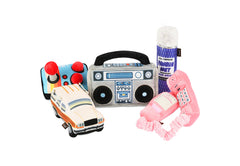Every dog owner just wants the very best for their pooch. But what if we are not actually sure what “the best” is?
When it comes to feeding our dogs, we are all confused at one point or another. Chicken or beef? Grain or grain-free? And what type of food is the best - wet food, raw food, dry food, or something else?
As a professional dog trainer I get asked every day what the right food for dogs is. Today I will share my thoughts with you, so that you can be assured that you get the very best food for your pup!
Dry Food - Pros & Cons
Dry food (or kibble, as it is often called) is the most common food for dogs. You can find it in hundreds of different flavors, shapes and sizes as well as from a variety of companies and in many different levels of quality.
Dry food is the easiest food to feed, as well as the most affordable. You can store it over weeks and months. Most puppies or shelter dogs come into their forever homes eating dry food already.
There are downsides to dry food though. If you own a senior dog who has lost some teeth, dry food will be too hard for him to chew. You will need to soak the food in water, or switch to wet food.
Many lap dog breeds such as Chihuahuas do not appreciate dry food. They seem to dislike the taste and often do not like to chew either. In addition, many small dog breeds are especially prone to losing teeth earlier on in their life.
Wet Food - Pros & Cons
Wet food is often very popular for even the most picky dogs. If you have a dog that has turned his nose up on dry food, chances are he will happily take the wet food you offer. Wet food can be easily stored for months or years in unopened cans and is widely available.
Wet food is much more pricey than dry food, especially if you own a large-breed dog. The more your dog eats, and the higher-quality your chosen wet food is, the faster the price will grow. It can easily reach and exceed $10-15/day.
Another downside of wet food is that it is messy - making it a poor choice for dogs that have a long and curly coat, such as the Bernedoodle. Food can get stuck in the hair and you will have to clean up your dog after each meal - which is time-consuming and not fun at all!
Raw Food - Pros & Cons
Over the last 5-10 years, feeding dogs with raw food has become increasingly popular. Some owners choose to buy premade raw food (which you can find in pet stores, or order specifically made for your dog on the internet) while others buy the raw meat themselves and portion it at home.
A very appealing factor of making one’s own raw food is that it can be very affordable while also providing a high-quality diet. But watch out! This is more involved than you might think.
When raw feeding it is extremely important to be knowledgeable of your individual dog’s nutritional needs. A Doberman puppy will have different needs than a senior Pug, who will have different needs than a nursing Golden Retriever momma with puppies. In kibble and wet food, the manufacturers already designed the nutritional profile to fit exactly what the dogs they are targeting need. When preparing your own raw food, this is your task!
Dogs that are raw-fed need a lot more than simply “raw meat”. They require organ meat, muscle meat, bones and potentially eggs, raw vegetables and fruits as well.
A well-balanced raw diet can really bring out the best in your dog. On the downside, a poorly designed raw diet can lead to nutrition deficiencies and even stunted growth in puppies.
Another consideration is whether you have the ability to safely prepare raw food in your home without the risk of cross-contamination. Especially raw poultry can be dangerous to humans if consumed. If you have young children who might come into the kitchen, touch your cutting board and lick their fingers - raw feeding is not for you!
How To Choose The Right Diet For Your Dog
When deciding on the right diet for your particular dog, take into account your dog’s age, size, breed; your budget and lifestyle as well as your time constraints. Here are some guidelines to help you decide:
-
Is your dog a senior dog?
Chances are that dry kibble is too hard for him. You should either soak it or pick a wet food. You can also mix dry food with a bit of wet food - this is less expensive than feeding only wet food, while being much more tasty than pure kibble. -
Is your dog a large breed dog?
If your dog is a large breed, especially if he weighs over 80 pounds, price of food can become an important factor to consider. Especially if you are on a budget, dry food will be the best option for you. -
Do you have several dogs?
If you own several dogs, feeding a home-made raw diet can provide them all with high-quality food while not breaking the bank. It is much more time-efficient to prepare raw food for 4 dogs at once than just for 1 dog. You might be able to get special deals at your local butcher shop - check with them! -
Do you have small kids?
If you have little kids at home, I strongly encourage you to not pursue a home-made raw diet for your dog at this point. The risk of contamination from raw poultry is too large with children around. You could however look into getting a commercially prepared raw diet if you want your dog to eat raw meat. -
Are you doing dog sports such as agility with your dog?
If your dog is athletic and participates in dog sports such as agility - or if you enjoy taking him on long hikes and camping trips - he will need specific nutrition to fit his energy needs.
You should look into getting a high-quality kibble (there are some products specifically made for sports dogs) or into a well-balanced raw food diet.
The Bottom Line
It is impossible to make a blanket recommendation on which dog food is the best. As always, when it comes to making the best choices for our pooch we need to take into account his or her specific likes, dislikes, age, breed and our lifestyle.
What is the perfect food choice for a bachelor who takes his German Shorthair Pointer mountain-biking will not be the perfect choice for a retired couple who have an elderly Shih Tzu.
Consider your dog’s condition as well as your budget when it comes to picking the right food.
Of course, if you have any doubts about how to make the right decision, check with your local veterinarian who can assist you in finding the perfect diet for your dog.






